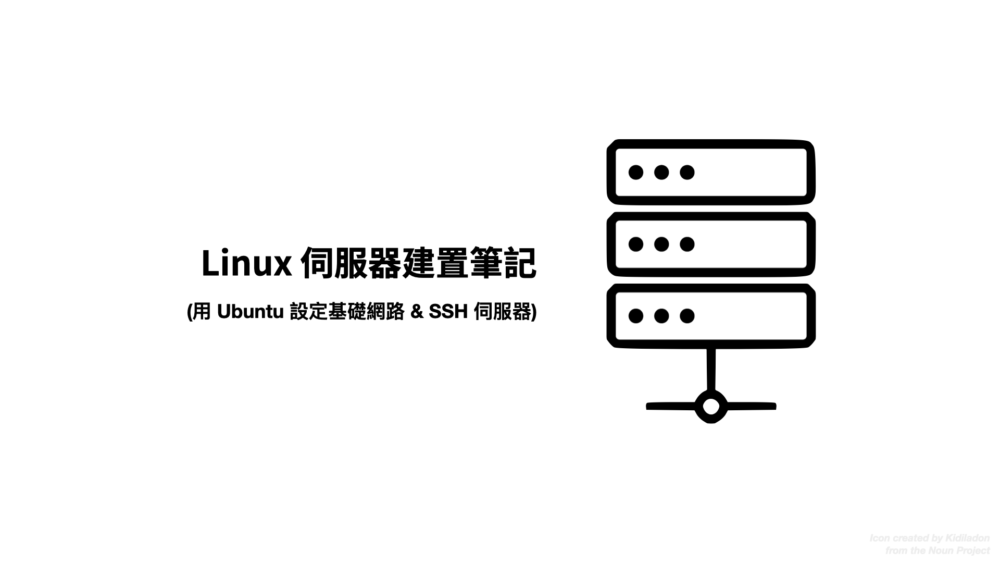這邊整理了一些手動 Linux server 伺服器安裝,需注意的一些事情與指令。
備忘一下以備不時之需。
(如果是設定雲端主機的話,部分步驟可以跳過,它預設都幫你建好了。)
製作可開機 USB (Bootable USB)
使用 UNetbootin 軟體
軟體下載:https://unetbootin.github.io/
選擇 USB drive,選擇 ISO 就可以了
針對目標機器做開機。
Mac 系統的話,可以使用 Etcher
軟體下載:https://www.balena.io/etcher/
做法差不多
選擇作業系統:
- Debian 系列:可選擇 Ubuntu, Debian
- RedHat 系列:可選擇 RHEL, CentOS, Fedora
- BSD 系列:可選擇 FreeBSD
- SUSE 系列:可選擇 OpenSUSE
前二項是筆者較為熟悉的,推薦 Ubuntu, Debian, CentOS 做為選項。
ISO 的版本很多:
- Desktop ISO:有一個完整的 Live CD 可供試用
- Server ISO:有預載一些伺服器使用的套件
- Minimal ISO:只是檔案小,預設網路驅動了之後,大多都從網路上抓
不知怎麼選擇的話,預設就選 Desktop ISO。
(以下撰文用 ubuntu 做示範)
網路指令相關
這邊列出常用的網路指令,如果網路不通的事情,當然要優先處理。
列出網路介面與 IP 位址
$ ip a
$ ip addr show
$ ifconfig這幾個指令都可以,輸出格式稍有不同。
列出路由閘道 Gateway 設定
$ route -n設定網路連線資訊
這邊介紹一個新東西:netplan
網路對它介紹不多,但個人覺得非常可以取代目前網路設定不方便的窘境。
假設你要設定的網路連線資訊如下:
-
目標介面: eth0
-
IP 位址 (IP Address): 192.168.10.200
-
子網路遮罩 (Netmask): 255.255.255.0 (/24)
-
網路閘道 (Gateway): 192.168.10.1
-
主要 DNS 為 8.8.8.8
-
次要 DNS 為 168.95.1.1
(請根據你的自身環境修改,這裡只是舉例)
只要找到 /etc/netplan/01-netcfg.yaml 這個檔案並編輯
$ sudo vi /etc/netplan/01-netcfg.yaml修改成類似以下內容:
network:
version: 2
renderer: networkd
ethernets:
eth0:
addresses: [192.168.10.200/24]
gateway4: 192.168.10.1
nameservers:
addresses: [8.8.8.8,168.95.1.1]
dhcp4: no(請根據你的自身環境修改,這裡只是舉例)
就這樣而已,省二、三個指令,簡單又直覺。
如果你要 dhcp (自動取得 IP 位址) 那更簡單了:
network:
version: 2
renderer: networkd
ethernets:
eth0:
dhcp4: yes然後存檔離開
執行一個很直覺的指令: netplan try
$ sudo netplan try
Do you want to keep these settings?
Press ENTER before the timeout to accept the new configuration
Changes will revert in 120 seconds是否要保留設定?按 Enter 保留設定,不然 120 秒後會復原。
就跟切換螢幕解析度一樣簡單。
爾或者可以用 netplan apply 直接套用。
$ sudo netplan apply(舊式) 設定 IP 位址 (IP Address)
$ sudo ip addr add 192.168.10.200/24 dev eth0這邊用 192.168.10.200 做為例子,請修改成恰當的值。
(舊式) 設定網路閘道 Gateway
$ sudo route add default gw 192.168.10.1 eth0這邊用 192.168.10.1 做為例子,請修改成恰當的值。
(舊式) 設定 DNS
$ sudo echo nameserver 8.8.8.8″ > /etc/resolv.conf這邊用 8.8.8.8 的 Google DNS 做為例子,你也可以調整成你喜歡的。
DHCP Relase
釋放從 DHCP 取得的 IP 位址
$ sudo dhclient -r指令等同 Windows 裡的 ipconfig /release
DHCP Renew
從 DHCP 重新取得新的 IP
$ sudo dhclient指令等同 Windows 裡的 ipconfig /renew
啟動/關閉 網路介面 (ip 指令)
$ ip link set dev eth0 up
$ ip link set dev eth0 down例如介面名稱為 eth0,請自行修改成合適的網路名稱。
啟動/關閉 網路介面 (ifconfig 指令)
$ /sbin/ifconfig eth0 up
$ /sbin/ifconfig eth0 down例如介面名稱為 eth0,請自行修改成合適的網路名稱。
列出所有網路介面與狀態
$ ip link show
$ ifconfig -a這二個都可以
檢查外部公有 IP (Public IP)
$ curl ipinfo.io/ip一個簡單的指令可以查詢外部公有IP地址 (Public IP)
SSH 相關
安裝 SSH Server (應該預設就有安裝了)
應該預設就有安裝了,如果沒有安裝,請手動用指令安裝之。
(以下為 ubuntu 的指令)
$ sudo apt install -y ssh openssh-server開機預設啟動 ssh
$ sudo systemctl enable ssh啟動 ssh
$ sudo systemctl start ssh查看 ssh 狀態
$ sudo systemctl status ssh使用 ssh key 取代密碼登入
增加方便性也加強安全性,建議用 ssh key (pem) 檔案來登入 ssh。
產生 ssh key
$ ssh-keygen指定檔案,例如 id_rsa 檔案(檔名可自訂)。
密碼 passphrase 可以留空
將會產生 id_rsa (私鑰) 與 id_rsa.pub (公鑰) 檔案。
接下來的步驟將是把您的公鑰複製到伺服器上(或者是把私鑰下載回使用者電腦上)。
使用者(你)透過電腦上的私鑰來做連線。
自動複製 ssh key
(在 Client 端執行此指令)
這個步驟是自動把您的公鑰複製到伺服器上。
$ ssh-copy-id -i ~/.ssh/id_rsa -p 22 [email protected]如果不能運作也不用太糾結,等等有手動的方式。
運行結果:
/usr/bin/ssh-copy-id: INFO: Source of key(s) to be installed: "/Users/user/.ssh/id_rsa.pub"
The authenticity of host '[192.168.10.200]:22 ([192.168.10.200]:22)' can't be established.
ECDSA key fingerprint is SHA256:wYmwxxxxxxxxxxxxxxxxxxxxxxxxxxxxxxxxxxcFme8.
Are you sure you want to continue connecting (yes/no/[fingerprint])? yes
/usr/bin/ssh-copy-id: INFO: attempting to log in with the new key(s), to filter out any that are already installed
/usr/bin/ssh-copy-id: INFO: 1 key(s) remain to be installed -- if you are prompted now it is to install the new keys
[email protected]'s password:
Number of key(s) added: 1
Now try logging into the machine, with: "ssh -p '22' '[email protected]'"
and check to make sure that only the key(s) you wanted were added.另外一個指令,作法相同。
$ cat ~/.ssh/id_rsa.pub | ssh -p 22 [email protected] "mkdir -p ~/.ssh && cat >> ~/.ssh/authorized_keys"或者手動複製產生之公鑰 (PublicKey) 到伺服器的 ~/.ssh/authorized_keys 檔案。
(如果沒有 .ssh 隱藏資料夾與 authorized_keys 檔案,請自行建立。)
設定 SSH 關閉密碼登入
$ vi /etc/ssh/sshd_config找到這行並修改
PasswordAuthentication no設定免密碼 sudo
(這個步驟非必要)
在設定之前,先調整預設開啟的編輯器。
因為小弟長期習慣用 vim 所以用此指令先切換預設開啟的編輯器
$ sudo update-alternatives --config editorThere are 4 choices for the alternative editor (providing /usr/bin/editor).
Selection Path Priority Status
------------------------------------------------------------
* 0 /bin/nano 40 auto mode
1 /bin/ed -100 manual mode
2 /bin/nano 40 manual mode
3 /usr/bin/vim.basic 30 manual mode
4 /usr/bin/vim.tiny 15 manual mode
Press <enter> to keep the current choice[*], or type selection number: 3
update-alternatives: using /usr/bin/vim.basic to provide /usr/bin/editor (editor) in manual modeubuntu 預設是開 nano 編輯器,可以用這個來修改
可以選擇 3 改用 vim 編輯器。
然後使用該指令編輯設定檔
$ sudo visudo找到
%sudo ALL=(ALL:ALL) ALL把它改成
%sudo ALL=(ALL:ALL) NOPASSWD: ALL然後存檔離開。
連線 SSH
這個可以做為 bash script 以後方便使用。
$ ssh -i ~/.ssh/id_rsa -p 22 [email protected]軟體更新
時時軟體更新、修補漏洞、修復 Bug 是很重要的,以下是一些常用的指令
更新套件庫清單(取得有哪些套件已更新)
$ sudo apt update -y更新套件
$ sudo apt upgrade -y確認版號
$ lsb_release -a其實另外二個都可以,個人比較喜歡這個
$ cat /etc/os-release
$ hostnamectl列出 Linux 核心版本號
$ uname -r整個大版本更新
例如從 ubuntu 20.04LTS 升到 ubuntu 22.04.2LTS
$ sudo do-release-upgrade參考資料
https://www.cyberciti.biz/faq/ubuntu-linux-install-openssh-server/
https://www.digitalocean.com/community/tutorials/how-to-configure-ssh-key-based-authentication-on-a-linux-server
https://vitux.com/ubuntu-ip-address-management/
https://www.cyberciti.biz/faq/howto-linux-renew-dhcp-client-ip-address/
https://tldp.org/HOWTO/Linux+IPv6-HOWTO/ch05s02.html
https://www.cyberciti.biz/faq/upgrade-ubuntu-20-04-lts-to-22-04-lts/

